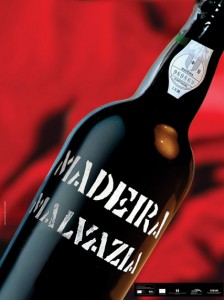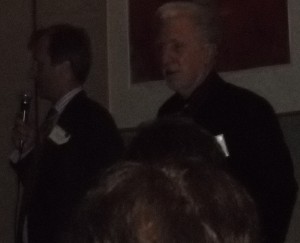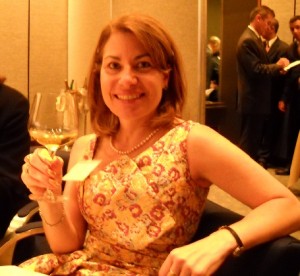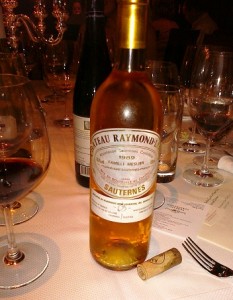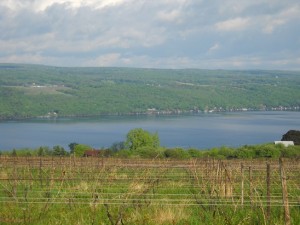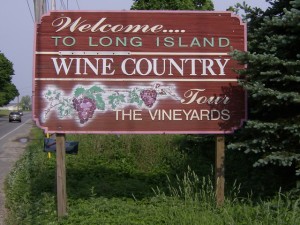 We hope you enjoyed the holiday weekend and are having a great summer!
We hope you enjoyed the holiday weekend and are having a great summer!
We continue to be busy, but have no complaints. In late June, Tracy participated in a video shoot for a segment of Wine Portfolio, an online television show that airs on CNBC. The segment focused on Wine Shopping in New York City, with stops at Sherry-Lehmann, Bottle Rocket and Chelsea Wine Vault. Host Jody Ness and the entire crew were a pleasure to work with. The episode won’t air for several months, but we’ll keep you posted when we have more details.
This month, Tracy was asked to serve as the judge for a special event celebrating Caymus’ Conundrum, which was paired with a range of take-out cuisine in search of the best match. This wine is a “proprietarily secretive blend of California white grapes”, drawing from Sauvignon Blanc, Muscat Canelli, Chardonnay and Viognier, and a combination of stainless steel and barrel fermentation that results in an unusual, but wonderful wine.
Later this month, Tracy will present “Born in the USA: American Sparklers” at the Society of Wine Educators’ annual conference in Washington, D.C.
And, back at home, we invite you to save the date for the first HARVEST Wine Auction & Celebration of Long Island’s East End, September 24-25, 2010. Grand Cru Classes will offer its “From Mystery to Mastery” class (Saturday, September 25, 11:00 AM -1:00 PM) through the event’s Wine Salon, as part of this two-day extravaganza, which culminates in a Grand Tasting and Gala Dinner at Wolffer Vineyards.
Many of our readers are familiar with the East End and understand what there is to celebrate, but for those that are less familiar, we share some of the history and current state of affairs of the East End with you this month. Drink wisely and well,
Tracy Ellen Kamens, Ed.D., DWS, CWE
CEO: Chief Education Officer
and
Jared Michael Skolnick
COO: Cork Opening Officer
From Potatoes to Parker Points
Agriculture has long been a feature of the North Fork, with the potato industry achieving prominence, along with cauliflower and other crops. But, times have changed. Today, the potato fields have given way to vineyards and vacationers.
With the first vineyard planted in 1973 by a young, starry-eyed couple fresh out of Harvard, the first seeds (or rather vines) of the Long Island wine region were sown. That couple, Louisa and Alex Hargrave, were true pioneers, bringing vision and bravado to their newly purchased farm. Much like the early English settlers that preceded them, Alex and Louisa came to the task with limited knowledge, but unlimited passion and drive, pushing them to succeed where others were sure they would fail. Before long, they were joined in their efforts by other adventurous souls, all of whom were in love with wine. As time flew by, a fledgling wine region was born, eventually becoming an internationally recognized producer of quality wine.
The region now garners consistent coverage in the New York Times with Howard Goldberg’s bi-weekly column. Howard’s colleague, Eric Asimov, has lauded Long Island’s efforts in his own columns with increasing frequency, for both current and vintage wines. Additional publicity has been accomplished with big spreads in Wine Spectator and other glossy magazines, giving greater credibility to the region. Building on their accomplishments, the return visit of Robert Parker’s Wine Advocate, long considered to be among the most influential (albeit controversial) wine publications, proved to be a boon with all wines scoring a minimum of 84 and 23 wines earning scores of 90 or above (the highest score was 92). Across the pond, Decanter magazine has recognized the region with profiles of wineries and medals awarded to Long Island wines.Today, the Long Island wine region is home to 60 vineyards and 51 wine producers (35 of which are open to the public) and has garnered repeated praise in both consumer and trade publications. Moreover, the bucolic region has retained much of its rural charm, making it a true escape from the hustle and bustle of New York City, located only two hours away.
The wineries welcome visitors to their tasting rooms, each of which has its own special atmosphere. Guests can generally taste through a flight of wines for a small fee or can often choose to buy wine by the glass to enjoy in the wonderful surroundings. Of course, wine by the bottle and case is available for sale as well. Nearly year-round, but particularly during season (Memorial Day through Thanksgiving), the wineries play host to a wide variety of activities from jazz musicians and blue grass bands to dog shows, comedy festivals and other special events.
>Learn more about the region’s wineries through the Long Island Wine Council’s website.
Tasting Notes
Brooklyn Oenology Viognier 2007, North Fork of Long Island (NY), USA, $18.00
Owner and winemaker Allie Shaper is also the new face behind the wines at Comtesse Therese. Aromas of melon and spice give way to a dry palate with ripe tropical fruit and melon notes.
Shinn Estate, Estate Coalescence 2009, North Fork of Long Island (NY), USA, $14.00
Restaurateurs turned wine producers, David Page and Barbara Shinn produce elegant wines that are extremely food-friendly. A blend of Chardonnay, Sauvignon Blanc, Merlot Blanc and Riesling, this wine has a pronounced nose with a dry palate, showing grassy notes with citrus and a hint of floral and spice.
Corey Creek Vineyards Domaines CC Rosé 2007, North Fork of Long Island (NY), USA, $18.00
Corey Creek, a sister property to Bedell Cellars, has always been known for its rosé. Bright berry aromas greet the nose;in the mouth, it is dry with fruity, fresh berries that persist on the palate.
Jason’s Vineyard Merlot 2000, North Fork of Long Island (NY), USA, $14.95
A second generation winemaker on the North Fork, Jason is the son of Dr. Damianos, owner of Pindar and Duck Walk Vineyards. At 10 years old, this wine has an aged bouquet of dried fruit and flowers. It is dry, with medium+ acidity, dried berries and cherries, spice and oak.
Castello di Borghese, Merlot 2005, North Fork of Long Island (NY), USA, $20.00
The original Hargrave vineyard and winery was sold to Prince Marco and Princess Ann Marie Borghese in 1999 where they continue the legacy started in 1973. This wine shows notes of meat and fruit on the nose with black cherry, plum, oak and meat flavors that linger throughout the long length.

